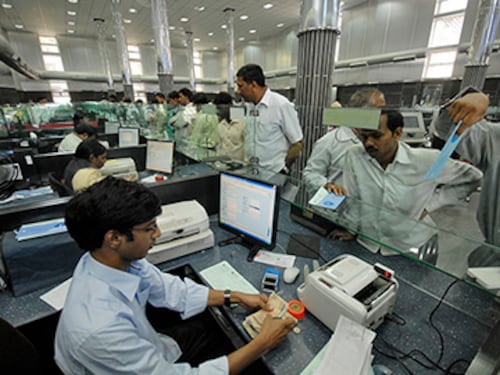Indian government on warpath to make PSU banks breathe
SBI, Bank of Baroda, Bank of India, Canara Bank seen as top gainers


The government is on a warpath to create the right dynamics for public sector banks (PSBs) to operate in. Several of these banks have, for months, been struggling with high levels of bad loans and a not-too-encouraging lending environment. Last week, the government embarked on “Gyan Sangam”, a two-day retreat, where finance ministry officials and senior heads of PSBs and financial institutions are meeting to discuss issues relating to bad debts, mergers and acquisitions and credit growth.
Earlier on March 1, the Reserve Bank of India (RBI) announced the easing of criteria to calculate the core equity capital of PSBs. This is part of the move which would help align the definition of regulatory capital with the internationally-adopted Basel III framework, analysts said. A day prior to that, on February 29, in the Union Budget, Finance Minister Arun Jaitley had announced an allocation of Rs 25,000 crore for FY2016-17, towards recapitalisation of PSBs.
All of these measures are starting to create an impact. The Nifty PSU Bank index, which comprises 12 state-run bank stocks, has – after months of a downswing – risen by 21.37 percent to 2388.75 on March 4, 2016, from a low of 1,968 on February 12 this year. Prior to this, the index had shed 36 percent between December 2015 and February 2016.
What the government did
For starters, it has admitted that India’s state-run banks are facing real problems.
Secondly, the recent RBI measure (to determine capital of PSBs) will result in banks’ shoring up their capital further. The RBI has allowed banks to include three items towards the calculation of common equity Tier-1 (CET-1), which is the bank’s core capital and a measure of its financial strength.
These items are:
a) Revaluation reserves – mainly fixed assets/property – which were being treated as part of Tier-2 capital up to now
b) Foreign currency translation reserves and
c) Deferred tax assets (DTA). The last two items had been completely omitted till now from such calculations.
So, in the case of revaluation reserves, the assets would be revalued at market value, minus a 55 percent discount. “This augurs well for PSU banks which are already reeling under capital constraints (like Union Bank of India, State Bank of India, Bank of India and Oriental Bank of Commerce) following higher asset quality stress and transition towards Basel III framework,” says Nilesh Parikh of Edelweiss Securities.
Parag Jariwala of Religare Capital Markets agrees: “The steps certainly alleviate some stress for the capital-starved PSBs.”
Impact of these measures
Each analyst or equity research firm we spoke to provided a different figure in terms of the impact for these banks. It is difficult to calculate the exact impact as, in the case of revaluation reserves, the number of branches owned verses rented and the value of each branch differs.
Jariwala says that unlike other countries, Indian PSBs own the majority of their branches / guest house and /or accommodation provided to employees. While some of these branches were purchased 50 to 60 years ago (their values highly understated in their respective balance sheets), a few banks would have revalued part of their real estate and the gains on account of this would be included in the revaluation reserves.
Prior to this, regulations permitted only 45 percent of revaluation reserve to be included in Tier-2 capital (fully excluded while calculating Tier 1 capital), Jariwala explained in a report.
Parikh of Edelweiss Securities estimates a total of 30 to 80 basis points (bps) gain for PSBs on their CET-1 capital. Jariwala of Religare expects a 90 to 100 bps improvement in CET-1 capital while Nomura’s analysts Adarsh Parasrampuria and Amit Nanavati estimate this to be at 90 to 100 bps for CET-1 capital.
State Bank of India, Bank of Baroda, Canara Bank, Bank of India and Union Bank would be top gainers, through these measures (see tables). With most stressed assets recognised as NPAs and with a limited exposure to infrastructure conglomerates, State Bank of India is seen by several analysts as a preferred pick among public sector bank stocks.
Recapitalisation moves
Jaitley has already committed Rs 25,000 crore of capital infusion for PSBs in FY 2016-17, which would help banks, though the quantum of capital announced has been questioned by analysts. This forms part of the Rs 70,000 crore announced by Jaitley for the four years ending FY2019.
When the announcement was made, analysts simply called the move inadequate.
“The government is not putting in extra money [where it is required],” said Pankaj Agarwal, analyst at Ambit Capital. “This is not what banks had expected.” Agarwal estimates that PSBs need capital to the tune of $30 billion to $40 billion, while only about $6 billion to $7 billion is being injected.
First Published: Mar 09, 2016, 12:43
Subscribe Now